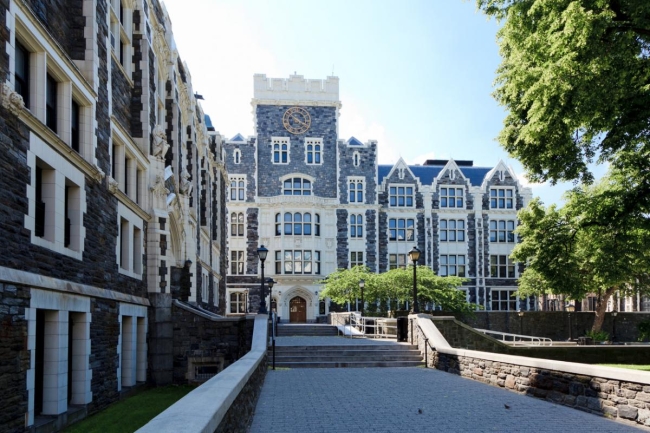You have /5 articles left.
Sign up for a free account or log in.

City College of New York
Istockphoto.com/mizoula
Students at City University of New York colleges and at community colleges throughout the state remain underserved by New York's Excelsior Scholarship program, a free tuition program for students at both two- and four-year public institutions.
That's according to the Center for an Urban Future, a think tank in New York City, which analyzed the state's flagship free tuition program after receiving the latest data from 2018 through a Freedom of Information Act request.
While the number of students in the program is growing, it faces some of the same problems the center highlighted in a 2018 analysis of 2017 data.
"With massive economic disruptions happening in real time, it's never been more important to offer New Yorkers access to an affordable college education," Eli Dvorkin, editorial and policy director at the center, said in a statement. "But while the state's Excelsior Scholarship program is well intentioned, the data shows that it's reaching far too few of the financially vulnerable students at community colleges statewide who most need the support to succeed in college."
The state's Higher Education Services Corp. did not respond to a request for comment by this article's deadline.
Previously, the governor's office has said that Excelsior was meant to layer on top of existing financial aid programs serving low-income students, such as New York State's Tuition Assistance Program, which could cover much of their costs.
The number of awarded scholarships increased from 20,458 in 2017 to 25,100 in 2018, nearly a 23 percent jump. Still, the share of New York undergraduates who received Excelsior funding remains relatively low, increasing from 3.2 percent in 2017 to 4 percent in 2018.
One reason for the increase in awards could be a change in the program's income threshold. In 2017, students from households making less than $100,000 were eligible. By 2019, the threshold was increased to $125,000.
Community college students in the state in particular are underserved by the program, according to the report.
"I think the data puts numbers to the story that we thought would emerge from the design of the scholarship program," said Karen Stout, president and CEO of Achieving the Dream, a nonprofit membership organization committed to improving student success at community colleges. "That in the design of the program, community college students would be underserved and undersupported."
Statewide, community college students make up about 48 percent of all undergraduates, but they received about 19 percent of the Excelsior scholarships in 2018. This was actually down from 24 percent of awards in 2017.
Meanwhile, students at larger four-year universities outside New York City disproportionately received the award. For example, the University at Albany has 2.2 percent of all enrolled students, yet it received 6 percent of all scholarships. The University at Buffalo has 3.5 percent of enrolled students but received 7.2 percent of all scholarships.
More than 1,000 students received the award at each of four State University at New York institutions. But only nine students at CUNY's Hostos Community College and 10 students at Bronx Community College received the award.
All CUNY colleges, aside from Hunter College, received a share of the total number of scholarships that was below their share of total state enrollments. About half of SUNY colleges received a share of scholarships that was above their share of enrollments.
Some experts say it's too soon to tell how the Excelsior program will grow and impact students in the long term.
"I look at all of this as an early-stage reboot of what was a historical commitment to keep college affordable for the low and middle class," said Martha Kanter, executive director of the College Promise Campaign.
While New York could work on its messaging about the Excelsior program, Kanter said it's still exciting that more than 25,000 students are benefiting so far.
The state is off to a great start, according to Martha Parham, senior vice president of public relations for the American Association of Community Colleges.
"Anything we can do to increase access and resources for those who wouldn't otherwise have it" is a good thing, she said.
It's possible the program's eligibility requirements could prevent community college students from participating. Excelsior requires students to be enrolled for at least 12 credits each term, and students can't have a break in enrollment.
While the report notes that this is partly why on-time graduation rates have been higher for Excelsior students than non-Excelsior students, it could also be why fewer community college students are enrolled in the program. Many work full-time or part-time jobs, which could make juggling a full course load difficult.
"Just knowing the characteristics of community colleges, you’re shutting out many who could’ve benefited," according to Stout.
Making the program available for all public colleges, and not just two-years, also likely put community colleges at a disadvantage, she said.
While Stout praised the overall increase, she said the data provide an opportunity for the state to look at how the scholarship is designed and to ensure it's helping the students it's meant to help while also aligning with workforce needs.
Updated data on applications and rejections were not available, the report says, but the previous analysis found that, in 2017, having insufficient credits was the main reason applicants were rejected from the program.
Recipients are also required to live within New York State for the amount of time they received the award, or it turns into a loan.
Before the novel coronavirus started to spread across the globe, Stout would have recommended modifying Excelsior. Now, as the virus upends higher education and triggers a recession, there's more urgency.
"These promise programs are more important now than ever," she said. "How do they need to be rapidly redesigned to make sure that students who are rapidly falling out of the pipeline can re-enroll in the fall?"




